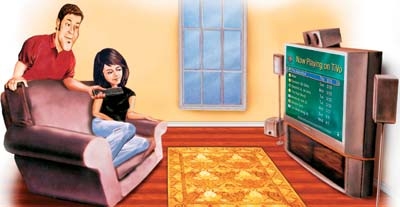Back to Basics: How to Set Up a DVD Player or DVD Recorder Page 2
From Recorder to TV While many people route all their audio and video signals through a receiver, some still prefer to hook up their DVD recorders directly to their TVs, just like they did with their VCRs. We'll consider this most basic type of recording setup before moving on to more flexible options. 
First, disconnect all the cables from your VCR since the DVD recorder is going to take its place. (You can reconnect the VCR later.) If you plan to use the recorder's tuner for switching TV channels, next connect the antenna (RF) output from your cable box or satellite-TV receiver to the recorder using a standard coaxial cable (the twist-on kind used in all TV installations). Sometimes this is the only kind of connection to the recorder a cable box or satellite receiver will let you make.
But all recent models give you the option of using either the standard RF connection or separate audio and video outputs. If yours has separate A/V outputs, use them since they'll give you better picture and sound. Depending on your equipment, you might even have a number of alternatives for these connections.
If your cable box or satellite receiver has only composite-video and stereo-audio outputs, connect these to the corresponding inputs on the DVD recorder. But more and more TV source components also have S-video and component-video outputs. As with connecting a plain DVD player, use component video if you can, S-video otherwise - most DVD recorders have a component-video output but, at best, only an S-video input. Similarly, while most DVD recorders have an optical or coaxial digital audio output, no current model has any kind of digital audio input. That means your recorder will accept only analog stereo, and you'll need to connect the receiver's stereo output to the recorder's audio input.
Even if you don't use the antenna output to connect your cable box or satellite receiver to your DVD recorder, you'll still want to make an RF connection from the source component to the TV so you can watch one live program while recording another. If you're not using a cable box or satellite receiver, you'll need to run the antenna cable directly to the DVD recorder's RF input so you can use the recorder's tuner to switch channels.
Important note While none of the current DVD recorders can record HDTV signals with full resolution, you can record HDTV to DVD at standard resolution. (Disc-based recorders that can handle high-def signals are on the horizon, but for now you need one of the few hard-disk recorders that can record high-def.)
Another important note You can't connect your VCR between a DVD recorder and your TV the way you used to connect it between your cable box and TV. If you send the signal from a DVD player through a VCR on the way to the TV, the copy protection on most commercial DVDs will make the VCR think you're trying to make an illegal copy - even if you haven't hit record! - and render the picture unwatchable. If you want to be able to record the same program on both DVD and videotape recorders, you can use an RF splitter to feed the same signal to both decks and then connect their outputs to separate A/V inputs on your A/V receiver or TV.
- Log in or register to post comments





























































